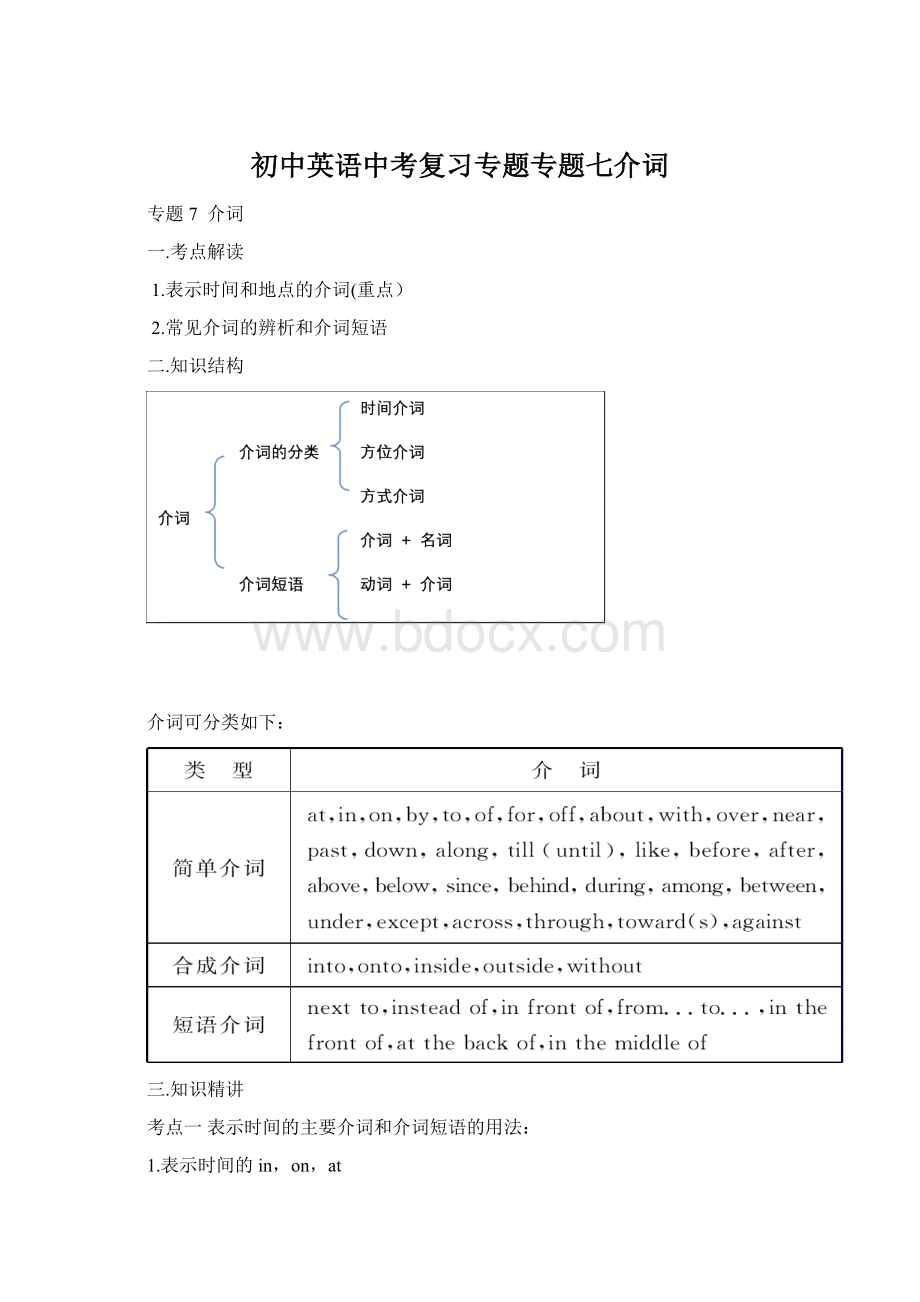 初中英语中考复习专题专题七介词.docx
初中英语中考复习专题专题七介词.docx
- 文档编号:5687949
- 上传时间:2022-12-31
- 格式:DOCX
- 页数:26
- 大小:77.99KB
初中英语中考复习专题专题七介词.docx
《初中英语中考复习专题专题七介词.docx》由会员分享,可在线阅读,更多相关《初中英语中考复习专题专题七介词.docx(26页珍藏版)》请在冰豆网上搜索。

初中英语中考复习专题专题七介词
专题7介词
一.考点解读
1.表示时间和地点的介词(重点)
2.常见介词的辨析和介词短语
二.知识结构
介词可分类如下:
三.知识精讲
考点一表示时间的主要介词和介词短语的用法:
1.表示时间的in,on,at
(1)at表示片刻的时间,或泛指圣诞节,复活节等。
常用词组有:
atthebeginningof,attheendof…,attheageof…,atChristmas,
atnight,atnoon,atthemoment,at3:
20等。
(2)in表示一段的时间,如世纪、朝代、时代、年、季节、月及一般(非特指)的早、中、
晚等。
常用词组有:
inthe20thcentury,inthe1950s,in1989,insummer,inJanuary,
inthemorning,inthepast,inthefuture,inone’sthirties,inred等。
(3)on表示具体某一天及其早、中、晚。
常用词组有:
onMay1st,onMonday,onNewYear’sDay,onacoldmorning,
onafinemorning,onSundayafternoon等。
总结规律:
“at时间点,有on必有天,in指月季年”
▲边学边练
(1)themorning
(2)Mondaymorning(3)arainyevening
(4)6:
50(5)2016(6)summer
(7)June(8)themorningofMay10(9)night
2.表示时间的in和after
两者都有“在一段时间之后”之意,但“in+时间段”表示时间从现在算起,常用语将来时态;而
“after+时间段/时间点”表示的时间从过去算起,多用于过去式。
Eg:
(1)Iwillfinishtheworkintwohours.两个小时后我将完成这项工作。
(2)Hereturnedhishometownafterhalfanyear.半年后他返回了他的故乡。
▲边学边练
(1)Hewillbebacktwohours.
(2)Theystartedworkinglunch.
(3)Theylefttwoweeks.
(4)HowsoonwillheflytoNewYork?
threedays.
(5)Thebuswillarrivetenminutes.
典例精析:
1).TheearthquakewhichhappenedinYushu______14thApril,2010wasabigdisaster.
A.atB.onC.inD.to
答案:
B
思路分析:
本题考查的是表示时间的介词的用法。
具体日期前用介词on,故选择B。
2).Thecaraccidenthappened______acoldwintermorning.Luckily,noonewashurt.
A.inB.onC.atD.of
答案:
B
思路分析:
本题考查的是表示时间的介词的用法。
专指某一特定的上午,下午和晚上,要用介词on。
例如:
onaspringmorning,故选择B。
3).ThefamouswriterWilliamShakespearewasborn______1564.
A.inB.onC.atD.of
答案:
A
思路分析:
本题考查的是表示时间的介词的用法。
某一年份前用介词in,故选择A。
区别:
after,before在……之后/之前
典例精析:
1).Thesinginggroupwillhavetwoperformances______October.
A.afterB.sinceC./D.for
答案:
A
思路分析:
本题考查的是表示时间介词的用法,在...之后要用after,故选A.
2).Thebookwassointerestingthathehadreaditforthreehours_____herealizedit.
A.whenB.untilC.afterD.before
答案:
D
思路分析:
本题考查的是表示时间介词的用法,表示在...之前要用before,故选D.
3.from的用法
表示从一点时间到另一点时间的一个阶段用介词“from…to…”
1.from9o’clockto11o’clock
2.fromFebruarytoApril
3.from1980to1990
4.fromthenon从那时候起(用于一般过去时),
fromnowon从现在起(用于一般将来时),fromtimetotime时不时地
▲边学边练
(1)Wehaveclass8o’clock10o’clock.
(2)Iwillworkhardnow.
(3)Hecallsmetimetime.
4.区别:
by和during
during:
表示“在……的期间”要用介词“during”,
during表示在特定的时间里,其后的名词前要用定冠词或者表示特定意义的代词。
1).duringtheweek
2).duringthosethreemonths
3).duringmyvisit
4).duringtheholidays/meeting
5).duringthespring
by+时间点:
表“在……之前”常用于完成时
e.g.Bytheendoflastyear,wehadfinishedourtask.
▲边学边练
(1)____theyear2012,wehavestayedinMGfornearly2years.
(2)____theparty,shesangalotofsongs.
补充:
by相关短语
1).坐飞机byair
2).偶然byaccident
3).错误地bymistakes
4).顺便说/问一下bytheway
5).(时间)流逝,经过goby
6).经过passby
5.not…until….
表示某动作或者状态延续到某一时间终止,用介词“till/until”
1.Theparkisopentill5p.m.
2.Hedidn’tleavetheparkuntil4p.m.
▲边学边练
Jim’sgone____Englandwithhisfamilyandhewon’tbeback___Monday.
A.for;onB.to;atC.for;tillD.to;until
6.for和since的区别
表示持续一段时间用介词“for”。
“for”+“段时间”
1).fortwohours/forthreedays
2).forhundredsofyears
3).forthelastthreeyears/forthepastthreeyears
4).forawhile
表示“自……以来”,表示从过去某一时刻到现在,用介词“since”。
“since”+“点时间”,主句常用现在完成时。
1).since1986/since1977
2).sincelastsummer/sincelastweek/sincelastmonth
3).sincethen从那时以后
4).sincehecamehere自从他来了以后
▲边学边练
(1).Hehasbeenateacher___10years.
(2).____2000,TomhasstudiedEnglish.
(3).JackandJohnhavebeenawayfromShanghai______fiveyearsago.
(4).Hisfatherhasbeen______Australia______1998.
A.to;inB.in;sinceC.to;fromD.in;for
7.from,since
from仅说明什么时候开始,不说明某动作或情况持续多久;
since表示某动作或情况持续至说话时刻,通常与完成时连用。
since表示"自(某具体时间)以来",常用作完成时态谓语的时间状语。
e.g.Theyhavebeenclosefriendssincechildhood.他们从小就是好朋友。
(1)sincethewar是指"自从战争结束以来",
若指"自从战争开始以来",须说"sincethebeginningofthewar"。
(2)不要将since与after混淆。
比较:
Hehasworkedheresince1965.
(指一段时间,强调时间段)自从1965年以来,他一直在这儿工作。
Hebegantoworkhereafter1965.
(指一点时间,强调时间点)从1965年以后,他开始在这儿工作。
典例精析:
1.___nowon,IwilllearnEnglishinthemornings.
A.SinceB.FromC.AfterD.At
答案:
B
思路分析:
本题考查的是表示时间介词的用法,从...时候开始要选用介词from,顾选B.
2.Mrs.BrownworkedinthewestofAustralia________lastsummer.
A./B.onC.inD.since
答案:
D.
思路分析:
本题考查的是表示时间介词的用法,表示从上个暑期开始要用since,顾选D.
总结:
时间名词前介词用法口诀
年前周前要用in具体日子要用on遇到几号也用on
上午下午得是in要说某日上下午用on换in记清楚
午夜黄昏用atat用在时分前说“差”可要用上to说"过''要用past
考点二表示地点的主要介词和介词短语的用法
1.表示地点的in,on,to在方位名词前
in表示在某一地区之内的方位(属于该范围)
on表示与某一地区的眦邻关系,即边界相连
to表示在某一地区之外的某方位,边界不相连
e.g.①AmericaisonthesouthofCanada.
②FujianisinthesouthofChina.
③JapanistotheeastofChina.
▲边学边练
(1)JapanistheeastofChina.
(2)GuangdongProvinceisthesoutheastofGuangxi.
(3)ChinaistheeastofAsia.
(4)CanadaliesthenorthofAmerica.
(5)TaiwanisthesoutheastofFujianProvince.
2.表示地点的in,on,at
at—表示较小的地点,in—表示较大的地方,on—表示在一个平面上。
A.in:
表示大地方,表示空间、地域或者物体内部应用in,或表示在…范围之内
e.g.在树上inthetree
在同一个班inthesameclass
在北京inBeijing
在世界上intheworld
在河里intheriver
在城市inacity
在阳光下inthesun
在北方inthenorth
在中国inChina
在第五中学inNo.5MiddleSchool
在……的前部inthefrontof
在……前面infrontof
在……中间/(内部)角落inthemiddle/cornerof
住院inhospital
在露天intheopenair
躺着看书readinbed
站成行standinline
处于危险中indanger
处于麻烦中introuble
惊奇地insurprise
B.at:
表示较小的地方,表示空间的某一点,出入口等,选at
在…的尽头attheendof
在大门口atthegate
在第二个十字路口atthesecondcrossing
在公共汽车站atthebusstop
在校读书atschool
在家athome
在医院诊所atthedoctor’s
在……头部/脚下atthehead/footof
在车站/机场/动物园/邮局atthestation/airport/zoo/postoffice
在前门atthefrontdoor
在影院/超市/会议室/聚会atthecinema/supermarket/meetingroom/party
待在家里stayathome
在工作atwork
在吃饭attable
C.on:
表示附着在表面上,覆盖等,表示接触的面上、边上、线上,用on
在墙上onthewall
在…的另一边ontheothersideof
在左边/右边ontheleft/right
在左/有手边ontheleft/righthandside
在火车上onthetrain
在电视/收音机/电话/网上onTV/theradio/thetelephone/theInternet
访问…onavisitto…
展览onshow
在……顶端onthetopof
在去…的路上onthewayto…
Eg:
①_____Shanghai.②_____home.③_____theground.
【考题再现】Tomtoldmehisparentshadarrived_____Beijing.
A.atB.onC.in
典例精析:
1.Ishallwaitforyou____thestation.
A.atB.onC./D.in
答案:
A
思路分析:
本题考查表示地点介词的用法,在车站要用介词at,顾选A.
2.Thereisawindow____thewall.
A.onB.inC.atD./
答案:
B
思路分析:
本题考查表示地点介词的用法,表示窗户在墙上要用介词in,顾选B.
3.Icanseefiveapples___thetree.
A.withB.atC.onD.in
答案:
C
思路分析:
本题考查表示地点介词的用法,表示苹果在树上要用介词on,顾选C.
▲边学边练
(1)HearrivedShanghaiyesterday.
(2)Theyarrivedasmallvillagebeforedark.
(3)Theteacherputupapicturethewall.
(4)Thereisabigholethewall.
(5)Thereisaboyswimmingtheriver.
3.infrontof和inthefrontof区别
infrontof=before表示“在某一范围之外的前面”
inthefrontof表示“在某一范围之内的前部”
eg:
①Tomisshortandalwayssits_________________theclassroom.
汤姆很矮,一直坐在教室的前面。
②Thereisatree__________________________myhouse.
我的房前有棵大树。
▲边学边练
①Thereisadesk_________________theblackboard.
②Theboysat__________________________thecar.
考点三易混介词的用法
1.between和among区别
一般来说,between表示两者之间,among用于三者或三者以上。
▲边学边练
(1)youwillsityourfatherandme.
(2)Heisalwayshappyhisclassmates.
2.by,with,in,through区别
(1)by+方式/手段/交通工具
Theclothesareallmadebyhand.
(2)with表伴随带着
Hecamebackwithsomefood.
(3)in+语言,材料,方式等意为用.....
CanyousinginEnglish?
Youshoulddoitinthisway.
Helikeswritinginink(墨水)
(4)through多指抽象概念,表达通过....
throughthestreet/window/forest(常考搭配)
Igottoknowhimthroughafriend.
区别:
across意为“从……表面穿过”,或沿某一条线的方向而进行的动作;
through意为“从……内部穿过”;
▲边学边练
(1)write______ink
(2)write__________apen
(3)sayit_________Chinese
(4)_______thisway
(5)__________moreexercise
(6)Heswam_______theriver.
(7)Theywalked_________theforest.
(8)Therivergoes_________thecityandbringspeoplewaterandfood.
(9)Hehelpedthelittlechildwalk_______theroad.
3.besides,except区别
(1)besides指除了...还有,再加上
Allwentoutbesidesme.加上我所有人都去了。
(2)except指除了,减去.....,不能放在句首
Allwentoutexceptme.除了我所有人都去了。
▲边学边练
()
(1)Wehaveclasseseveryday____Sunday.
A.besideB.besidesC.except
()
(2)Nobodyknewit____me.
AexceptB.besideC.besides
()(3)Doyouknowanyotherforeignlanguage____English.
A.exceptB.besideC.besides
4.over,under,above,below,on表示相对位置
over在...上方,一般指垂直方向,反义词是under
above在..上方指在上方的任意一点,表示在某物体上的高低位置,不接触,反义词是below
on在...上面,且互相接触
Eg:
Ourplaneflewabovetheclouds.我们的飞机在云端上飞行。
Afewbirdswereflyingoverthesea.有几只鸟在海上飞。
Thedogisunderthetable.这只狗在桌子下面。
Therearealotoffishesbelowthesurfaceofthewater.水面下有许多各式各样的鱼。
Thereisabookonthedesk.
▲边学边练
(1)Thereisabridge________theriver.
(2)Thereisaboat________thebridge
(3)Heputthebook________thedesk.
5.beside,behind
beside表示在……旁边behind表示在……后面
▲边学边练
(1)Ican'tseemybag,whereisit?
Oh,it'sthedoor.
(2)Thehotelisn'tfarfromhere.It'sneartheshop.
6.表示方式的介词
介词用来表交通,常把by,in,on来用;
限定、复数用in/on,by要直通海陆空;
骑马、骑车惯用on,小轿车前in才通。
(1).by+交通工具,意为“乘坐……”+某种手段,方法等
E.g.海:
beship/boat/sea
陆:
bybus/car/train/bike/taxi
空:
byair/plane/spaceship
(2)on:
+a/the/one’s+交通工具,意为“乘坐……”
+the+通讯工具
e.g.Hegoestoworkonthebike/inhiscar.他骑自行车/开车去上班。
in:
+a/the/one’s+car/taxi,+声音,语言
e.g.inahighvoice,inEnglish
3.with:
+某种具体的工具withaknife\stone
+人的某种器官withmyrighthand
表伴随状态(一个主要动作+次要动作)
e.g.
- 配套讲稿:
如PPT文件的首页显示word图标,表示该PPT已包含配套word讲稿。双击word图标可打开word文档。
- 特殊限制:
部分文档作品中含有的国旗、国徽等图片,仅作为作品整体效果示例展示,禁止商用。设计者仅对作品中独创性部分享有著作权。
- 关 键 词:
- 初中英语 中考 复习 专题 介词
 冰豆网所有资源均是用户自行上传分享,仅供网友学习交流,未经上传用户书面授权,请勿作他用。
冰豆网所有资源均是用户自行上传分享,仅供网友学习交流,未经上传用户书面授权,请勿作他用。


 对中国城市家庭的教育投资行为的理论和实证研究.docx
对中国城市家庭的教育投资行为的理论和实证研究.docx
